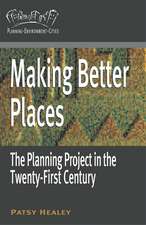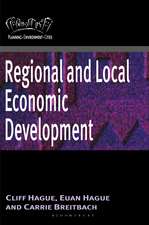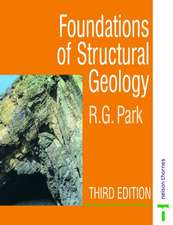Affect, Space and Animals: Routledge Human-Animal Studies Series
Editat de Jopi Nyman, Nora Schuurmanen Limba Engleză Hardback – 16 noi 2015
Part I explores how animals are framed as affective, through four case studies that deal with climate change, human–bovine relationships, and human–horse interaction in different contemporary and historical contexts. Part II expands on the issue of relationality and locates encounters within place, mapping the different spaces where human–animal encounters take place. Part III then examines the construction of animal subjectivity and agency to emphasize the way in which animals are conscious and sentient beings capable of experiencing feelings, emotions, and intentions, and active agents whose actions have meaning for the animals themselves.
This book highlights the importance of the ways in which affect enables animal agency and subjectivity to emerge in encounters between humans and animals in different contexts, leading to different configurations. It contributes not only to debates concerning the role of animals in society but also to the epistemological development of the field of human–animal studies.
| Toate formatele și edițiile | Preț | Express |
|---|---|---|
| Paperback (1) | 416.22 lei 6-8 săpt. | |
| Taylor & Francis – 16 iun 2017 | 416.22 lei 6-8 săpt. | |
| Hardback (1) | 1110.29 lei 6-8 săpt. | |
| Taylor & Francis – 16 noi 2015 | 1110.29 lei 6-8 săpt. |
Din seria Routledge Human-Animal Studies Series
-
 Preț: 310.09 lei
Preț: 310.09 lei -
 Preț: 326.14 lei
Preț: 326.14 lei -
 Preț: 312.09 lei
Preț: 312.09 lei -
 Preț: 311.06 lei
Preț: 311.06 lei -
 Preț: 444.62 lei
Preț: 444.62 lei -
 Preț: 479.63 lei
Preț: 479.63 lei - 14%
 Preț: 312.43 lei
Preț: 312.43 lei -
 Preț: 416.22 lei
Preț: 416.22 lei -
 Preț: 416.22 lei
Preț: 416.22 lei -
 Preț: 382.27 lei
Preț: 382.27 lei -
 Preț: 383.93 lei
Preț: 383.93 lei -
 Preț: 384.59 lei
Preț: 384.59 lei -
 Preț: 389.66 lei
Preț: 389.66 lei -
 Preț: 380.07 lei
Preț: 380.07 lei -
 Preț: 381.51 lei
Preț: 381.51 lei - 18%
 Preț: 1000.76 lei
Preț: 1000.76 lei - 9%
 Preț: 937.51 lei
Preț: 937.51 lei
Preț: 1110.29 lei
Preț vechi: 1354.02 lei
-18% Nou
Puncte Express: 1665
Preț estimativ în valută:
212.48€ • 221.01$ • 175.41£
212.48€ • 221.01$ • 175.41£
Carte tipărită la comandă
Livrare economică 14-28 aprilie
Preluare comenzi: 021 569.72.76
Specificații
ISBN-13: 9781138920941
ISBN-10: 1138920940
Pagini: 216
Ilustrații: 4
Dimensiuni: 156 x 234 x 14 mm
Greutate: 0.49 kg
Ediția:1
Editura: Taylor & Francis
Colecția Routledge
Seria Routledge Human-Animal Studies Series
Locul publicării:Oxford, United Kingdom
ISBN-10: 1138920940
Pagini: 216
Ilustrații: 4
Dimensiuni: 156 x 234 x 14 mm
Greutate: 0.49 kg
Ediția:1
Editura: Taylor & Francis
Colecția Routledge
Seria Routledge Human-Animal Studies Series
Locul publicării:Oxford, United Kingdom
Public țintă
Postgraduate and UndergraduateCuprins
1 Introduction PART I Being with Animals: Affect 2. Never-ending Stories, Ending Narratives: Polar Bears, Climate Change Populism, and the Recent History of British Nature Documentary Film 3. Cattle Tending in the "Good Old Times": Human–Cow Relationships in Late Nineteenth-Century and Early Twentieth-Century Finland 4. In Pursuit of Meaningful Human–Horse Relations: Responsible Horse Ownership in a Leisure Context 5. "... and Horses": The Affectionate Bond between Horses and Humans/Gods in Homer’s Iliad PART II Mapping Human–Animal Spaces: Relationality 6. Re-reading Sentimentalism in Anna Sewell’s Black Beauty: Affect, Performativity, and Hybrid Spaces 7. Seeing the Animal Otherwise: An Uexküllian Reading of Kerstin Ekman’s The Dog 8. Transcultural Affect: Human–Horse Relations in Joe Johnston’s Hidalgo, Steven Spielberg’s War Horse, and Belá Tarr’s The Turin Horse 9. What’s Underfoot: Emplacing Identity in Practice among Horse–Human Pairs Part III From Objects to Subjects: Exploring Animal Subjectivity 10. Moving (with)in Affect: Horses, People, and Tolerance 11. Companionable Human–Animal Relationality: A Reading of a Buddhist Jātaka (Rebirth) Tale 12. Passing the Cattle Car: Anthropomorphism, Animal Suffering, and James Agee’s "A Mother’s Tale" 13. An Avian–Human art? Affective and Effective Relations between Birdsong and Poetry Part IV Methodological Afterword 14. Ethnographic Research in a Changing Cultural Landscape
Notă biografică
Jopi Nyman is Head of English at the School of Humanities at the University of Eastern Finland.
Nora Schuurman is Postdoctoral Fellow at the University of Eastern Finland.
Nora Schuurman is Postdoctoral Fellow at the University of Eastern Finland.
Descriere
This book highlights the importance of the ways in which affect enables animal agency and subjectivity to emerge in encounters between humans and animals in different contexts, leading to different configurations. It contributes not only to debates concerning the role of animals in society but also to the epistemological development of the field of human–animal studies.












